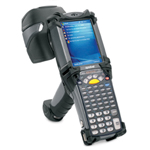
OPUS RFID
Re-Engineering the File Room with OPUS Intelligent Filing System
 RFID (radio frequency identification) technology has been incorporated into the OPUS Records Management Tracking software to extend as well as add functionality to its tracking capabilities. RFID (radio frequency identification) technology has been incorporated into the OPUS Records Management Tracking software to extend as well as add functionality to its tracking capabilities.
RFID tags and readers extend traditional barcode tracking and allow for productivity gains in circulation management and prevents time and manpower wasted on locating lost or misplaced files. The RFID tags co-exist with traditional barcode tagging allowing flexible alternatives while personnel perform circulation activities. Some of the typical circulation activities associated with RFID include:
- Check In/Out Kiosk - These workstations allow users (or file room attendants) to quickly check out files to ‘Requesters’. By utilizing the OPUS Self-Check module and RFID portal readers in open file rooms, one can rest assured that all files are accounted for. Portal readers will track a file as it leaves a secure area without actually having scanned the file out.
- Find A File - Utilizing OPUS Records Management Software missing files can be uploaded to the Portable RFID Readers allowing users to scan bulks of files within the office in an effort to locate these files. The RFID Reader will beep and notify the user when the missing file has been located.
- Inventory/Location Update - Portable readers are also used to update file location when files are moved from the file room thus allowing for quick inventory reconciliation reporting.
RFID Tags are Generation 2 Ultra High Frequency (UHF) operating at 862 - 928 Mhz. Tag sizes range from 2 x 2 inches to 4 x 6 inches and can be applied to the inside cover of most file folders. |


 RFID (radio frequency identification) technology has been incorporated into the
RFID (radio frequency identification) technology has been incorporated into the